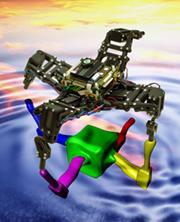 The robot constantly models its own body to work out how best to limp along. Watch a video here.
The robot constantly models its own body to work out how best to limp along. Watch a video here.Josh Bongard's robots walk, but they do not stride. They flop, wiggle, and scrape their way along on four, starfish-like legs. But what these robots lack in grace, they make up for in ingenuity.
The robots, created by Bongard and a team of engineers at Cornell University in Ithaca, New York, can sense and respond to damage without human instruction. Pluck off part of a leg, and they adjust their gait to compensate. Eventually, says Bongard, robots like these could crawl into high-risk areas on search-and-rescue missions, or explore distant planets where no humans are around to repair robotic injuries.
Each robot begins lying flat on the table, with no knowledge of how to walk. It makes small, random motions with each leg while Bongard's team feeds it information about its body's tilt and angle at each joint.
The robot uses the information to construct computer models that predict the outcomes of different movements, taking into account factors such as gravity, friction and momentum. It gingerly tests each model with small movements, much as a human leans on an injured foot to find out how much weight it can bear.
"When it's most uncertain about itself," says Bongard, who is now at the University of Vermont in Burlington, "that's when it moves the least." Once the robot has decided which movements best suit its situation, it sets off.
On the catwalk
When the robot's movements stop matching its model — if it has been injured, for example — then the robot builds a new model incorporating current conditions.
The selected models are not always successful. Sometimes a misstep sends a robot sprawling, or an errant thrust flips it onto its back, legs flailing like a stranded beetle. But most of the time, Bongard's team reports in this week's issue of Science, the robot can limp along1.
Other robots can respond to damage only if they have been programmed with a specific contingency plan, or if they randomly try all possible movements, which can mean cycling through hundred of thousands of permutations. Bongard's robots are more adaptable and efficient.
ADVERTISEMENT
"I haven't seen anything quite like it," says Ronald Arkin, director of the Mobile Robot Laboratory at the Georgia Institute of Technology in Atlanta. Bongard's robots are a new development in evolutionary robotics, says Arkin, a field that aims to build robots that learn from their environment without human help, and then teach other robots their skills.
At this point, Bongard's robots act as individuals. The next step, he says, is to create a network of robots that work together, with each member of the group learning from the injuries and adjustments of fellow robots.
The present generation reminds Arkin of the first Terminator movie, in which an evil robot with amputated legs drags itself in pursuit of the heroine. "One could argue that this is the precursor to being able to do that," he says.
Visit our robotslearntolimp.html">newsblog to read and post comments about this story.
